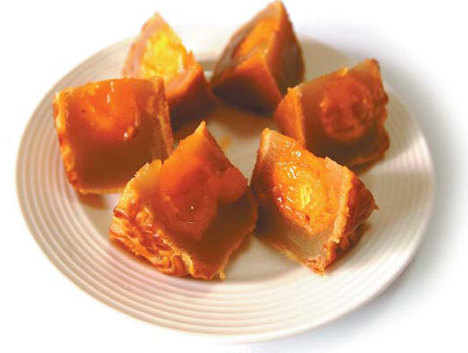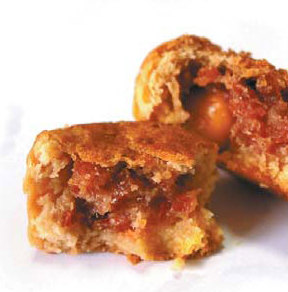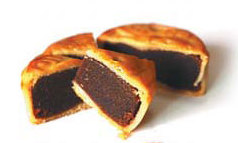Moon · Cakes · Tea
Updated: 2012-09-16 08:05
By Pauline D. Loh and China Daily Sunday team (China Daily)
|
|||||||||||

Soon, the mid-autumn moon will shine biggest and brightest, and Chinese all over the world will bask in its glow and take it as another opportunity to feast. Pauline D. Loh and the China Daily Sunday team share their pick of the best mooncakes.
The lotus paste should be so silky it melts in the mouth like soft, sweet butter, with an indulgent mouth-feel that can only come from the best Hunan lotus nuts. The pastry skin must be paper-thin, but delicately covering the cake completely so you do not see unseemly patches of naked filling.
The egg yolk inside should be a pale orange the color of the rising moon, and it should be seeping out just a little oil, moistening the lotus paste as the knife surgically slices the cake into six perfect wedges.
In the pastry of our dreams, every wedge should have a cross-section of yolk so the little cakes live up to their name.
For such attention to detail and perfection, you have to go south, to Hong Kong, where arguably the best mooncakes are made. Although mooncakes are shipped and sent all over the country, no one makes them like the Hong Kong pastry maestros.
You have the award-winning custard mooncakes from the Langham Hotel Hong Kong, where the tiny pastries are cranked up the ladder of sophistication, combining sifted salted egg yolks, fine bean puree and a delicate skin.
But the common man's favorite must still be Maxim's - available at every metro station in Hong Kong and where vouchers for next year's mooncakes start selling even before the crumb's from this year's pastries have been wiped off.
Yep, these vouchers are sold in a sort of tontine system that's been used for so long it's become a part of the household budget.
So are the southern moons better, brighter and sweeter?
Well, it's all about tradition and practice. They've just been doing it a lot longer.
In the austere years before an open economy helped the Chinese mainland catch up with the world, the selling and buying of mooncakes during the Mid-Autumn Festival was not a priority. But in the 30 years since, the market has taken a Great Leap Forward.
In fact, it sort of got away, once unfettered.
Mooncake gifts during the season became so extravagantly packaged that it raised Forbidden City eyebrows. The mooncakes are not so ostentatiously boxed now, but the country's couriers are still currently rushing to deliver stacks to clients, friends, family ... and media.
Many of us still remember the urban legend of the single mooncake in a gilded birdcage when the mooncake cost about 18 yuan ($2.80) and the birdcage reportedly cost 88,888 yuan. There were no details as to what flavor the mooncake was.
Fortunately, that sort of over-the-top opulence has since been tempered with a little taste. And talking of taste, you can just about get any flavor these days, much to the chagrin of those (like me) who think a mooncake should still be made of lotus or red bean paste, with just a few variations in-between.
For this feature, we sampled cranberry and red wine, corn and water chestnut, mocha and chestnuts, red bean and mochi (glutinous rice ball), candied winter melon and peanuts, spicy melon seeds, walnuts and ham, Yunnan ham and rose petal jam, jujube paste and walnuts, macadamia nuts and coffee, oolong tea, green tea, red tea ... and some other combinations we prefer to forget.
In short, anything that will stick in a paste has been stuck in the paste. We even have a bakery chain touting its French mooncakes, all baked like tarts. Like the old salty dog would say, there's no tart like a
In the modern compulsive, obsessive need for innovation, and the everyday motto of "let's be different", perhaps it would do good to remember that some traditions are best left untouched. Improved upon, maybe, but in still recognizable forms.
We'll let the pictures do the talking as we take you through some of the more delicious flavors we discovered. You can use our mooncake buying guide for reference.
PS: We paid for all our taste-test mooncakes. You can get similar ones at supermarkets, bakeries, or online. In addition, we have suggested some teas that we think will help wash down those sweet nothings.
Contact the writer at paulined@chinadaily.com.cn.

Salted egg yolk with lotus paste
This is the classic mooncake, with either a single or double brilliantly bright egg yolk in the center, softly cushioned by either white or red lotus paste. This is the truest form for the season, with its gently scalloped edges guiding you to the perfect six or eight wedges - meant to be delicately nibbled at and eaten between sips of the best tea, while gazing at the autumn moon amidst the cooling breezes.
Pastry: Traditional sweet glazed pastry
Filling: Lotus paste, melon seeds, salted egg yolk
Tea match: A nice heavy bodied tea like an aged Yunnan pu'er will cut the grease and ease those cholesterol concerns. When you brew pu'er, always pour away the first addition of hot water. The second brew is light, and the best brew is the third time you add water. Place in little purple clay teacups.

Yunnan ham with/without egg yolk
These are unique to Yunnan province, where its famous ham has won international awards. It's a salty-sweet filling that leaves a lingering fragrance in the mouth. Ignore what looks like bits of fat in the filling, it's candied winter melon, added for a tactile contrast to the very lean ham. These days, they also add nuts, seeds and rose-petal jam to the filling to accentuate the aroma.
Pastry: Flaky pastry
Filling: Chopped Yunnan ham, candied fruit and nuts, rose petal jam
Tea match: Yunnan highland green tea with its light, grassy scent will be the perfect match for the salty sweetness of this pastry. Or, you may want the province's famous fruit-infused tea, such as a rosella (hibiscus) and rose-hip tea.

Mung bean, red bean paste with sticky center
This is a new innovation that has not departed too far from traditional flavors. What the manufacturer has done is to add a sticky rice roll in the center, very much like the Japanese mochi.
Pastry: Biscuit crust
Filling: Red or mung bean paste with sticky rice ball.
Tea match: It has to be green tea for such texture and sweetness. A pot of lightly brewed green tea such as a Hangzhou Dragon Well, or even a Japanese green tea, will be the perfect match.

Red bean / jujube paste
Red bean is an affordable luxury in the north often used in classic Beijing snacks like ludagun (donkey rolling in the dust), made from a sticky cooked dough and rolled up. That is probably why this is the favorite filling in Beijing and its neighborhood. Sometimes, the red paste is made from jujubes, or the Chinese tree dates.
Pastry: Shortcrust pastry
Filling: Red beans or jujube paste. No yolks, no melon seeds.
Tea match: Go with the flow, and pair this typically northern flavor with a favorite Beijing tea, jasmine scented oolong, or hua cha. The scented tea will lift the subtle aroma of red bean paste, and the lightly bitter aftertaste of the jasmine tea will help ease the sweetness of the filling.

Five-seeds and ham
Melon seeds, pumpkin seeds, pine nuts, walnuts and sunflower seeds are the most commonly used. Seeds and ham sounds like a rather odd combination, but it is time-tested, especially in the south from the island of Hainan to Guangzhou to Shanghai. Candied winter melon forms a base filling, to which toasted nuts and melon seeds are mixed with finely minced ham. These should be sliced into thin wedges and enjoyed with a steaming pot of tea.
Pastry: Traditional sweet glazed pastry
Filling: Mixed nuts, melon seeds, chopped ham, five-spice powder
Tea match: With such nuttiness in the mouth, you need to have a tea that will enhance, rather than dissipate the spicy fragrance. Try an oolong tea, either from Fujian province Wuyi Mountain, or Taiwan's Ali Mountain.
Today's Top News
Rescuers race against time for quake victims
Telecom workers restore links
Coal mine blast kills 18 in Jilin
Intl scholarship puts China on the map
More bird flu patients discharged
Gold loses sheen, but still a safe bet
US 'turns blind eye to human rights'
Telecom workers restore links
Hot Topics
Lunar probe , China growth forecasts, Emission rules get tougher, China seen through 'colored lens', International board,
Editor's Picks

|

|

|

|

|

|





